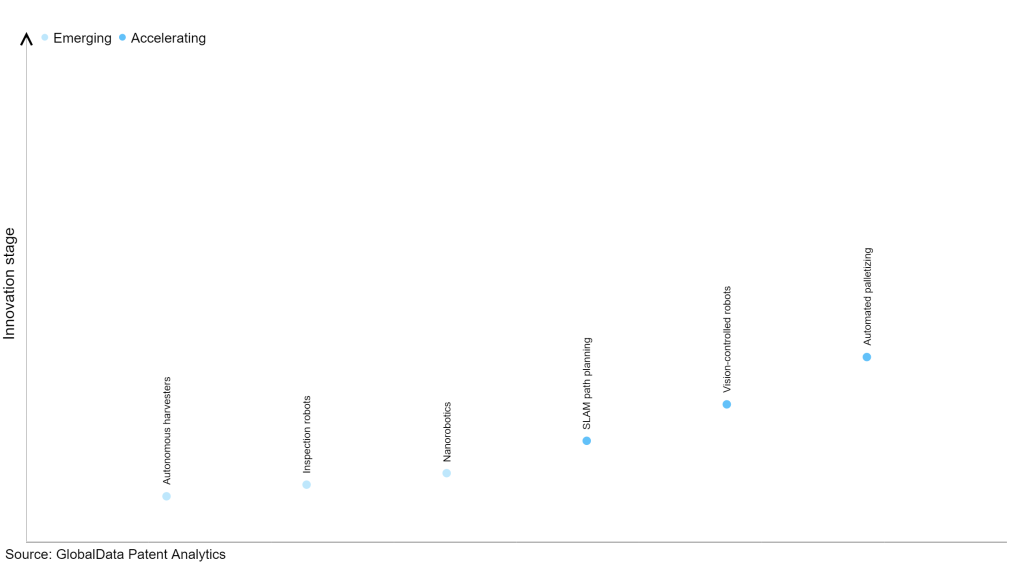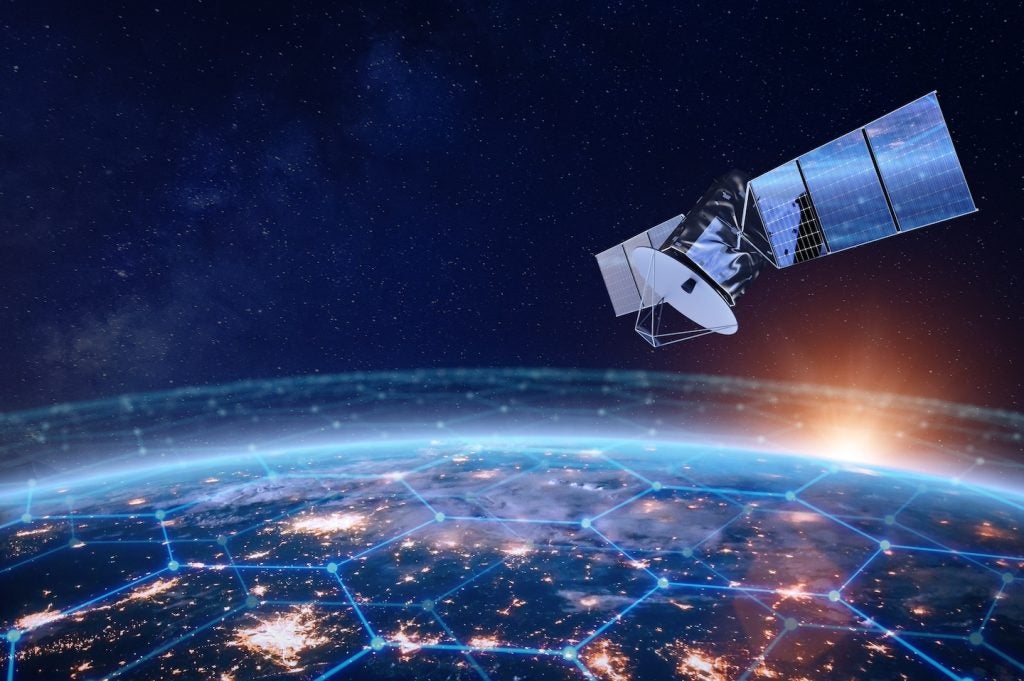The technology sector remains a hub of innovation, with advancements in robotics technology being a driving force. Developments in sensors, machine learning, and artificial intelligence have enabled the creation of robots that possess enhanced capabilities and versatility thereby growing importance of technologies such as computer vision, machine learning, GPS, sensors, and actuators. These technologies enable autonomous harvesters to operate efficiently and accurately, without the need for human intervention. In the last three years alone, there have been over 1.5 million patents filed and granted in the technology industry, according to GlobalData’s report on Robotics in technology: autonomous harvesters. Buy the report here.
However, not all innovations are equal and nor do they follow a constant upward trend. Instead, their evolution takes the form of an S-shaped curve that reflects their typical lifecycle from early emergence to accelerating adoption, before finally stabilizing and reaching maturity.
Identifying where a particular innovation is on this journey, especially those that are in the emerging and accelerating stages, is essential for understanding their current level of adoption and the likely future trajectory and impact they will have.
185+ innovations will shape the technology industry
According to GlobalData’s Technology Foresights, which plots the S-curve for the technology industry using innovation intensity models built on over 1.6 million patents, there are 185+ innovation areas that will shape the future of the industry.
Within the emerging innovation stage, autonomous harvesters, inspection robots and nanorobotics are disruptive technologies that are in the early stages of application and should be tracked closely. SLAM path planning, vision-controlled robots and automated palletizing are some of the accelerating innovation areas, where adoption has been steadily increasing.
Innovation S-curve for robotics in the technology industry

Autonomous harvesters is a key innovation area in robotics
Autonomous harvesters are self-operating machines employed in agriculture for crop harvesting. These machines can be in the form of unmanned aerial vehicles, ground-based robots, or underwater robots. They rely on a diverse range of sensors and technologies to identify, detect, and harvest crops. These technologies include GPS, image recognition software, and robotic arms that facilitate harvesting.
GlobalData’s analysis also uncovers the companies at the forefront of each innovation area and assesses the potential reach and impact of their patenting activity across different applications and geographies. According to GlobalData, there are 55 companies, spanning technology vendors, established technology companies, and up-and-coming start-ups engaged in the development and application of autonomous harvesters.
Key players in autonomous harvesters – a disruptive innovation in the technology industry
‘Application diversity’ measures the number of applications identified for each patent. It broadly splits companies into either ‘niche’ or ‘diversified’ innovators.
‘Geographic reach’ refers to the number of countries each patent is registered in. It reflects the breadth of geographic application intended, ranging from ‘global’ to ‘local’.
Patent volumes related to autonomous harvesters
| Company | Total patents (2010 - 2022) | Premium intelligence on the world's largest companies |
| Hexagon Technology Center | 6 | Unlock Company Profile |
| Hydro-Gear Limited Partnership | 9 | Unlock Company Profile |
| LG Electronics | 285 | Unlock Company Profile |
| Vorwerk | 8 | Unlock Company Profile |
| Honda Motor Europe | 4 | Unlock Company Profile |
| Samsung Electronics | 12 | Unlock Company Profile |
| Kubota Systems | 29 | Unlock Company Profile |
| TTI | 4 | Unlock Company Profile |
| Robert Bosch | 125 | Unlock Company Profile |
| ANDREAS STIHL | 57 | Unlock Company Profile |
| Active-Semi | 5 | Unlock Company Profile |
| Techtronic Outdoor Product Technology | 6 | Unlock Company Profile |
| Lely Patent | 5 | Unlock Company Profile |
| TTI (Macao Commercial Offsore) | 28 | Unlock Company Profile |
| Techtronic Cordless GP | 38 | Unlock Company Profile |
| Future General | 8 | Unlock Company Profile |
| iRobot | 114 | Unlock Company Profile |
| Yamabiko | 14 | Unlock Company Profile |
| Husqvarna | 582 | Unlock Company Profile |
| Zhejiang Geely Holding Group | 10 | Unlock Company Profile |
| Mamiya-OP | 15 | Unlock Company Profile |
| Honda Motor | 381 | Unlock Company Profile |
| Deere | 71 | Unlock Company Profile |
| MTD Products | 67 | Unlock Company Profile |
| Briggs & Stratton | 10 | Unlock Company Profile |
| Yanmar | 4 | Unlock Company Profile |
| Kubota | 52 | Unlock Company Profile |
| Al-Ko Geraete | 4 | Unlock Company Profile |
| VIKING | 5 | Unlock Company Profile |
| Toro | 67 | Unlock Company Profile |
| RobArt | 11 | Unlock Company Profile |
| Acconeer | 5 | Unlock Company Profile |
| Yanmar (Tokyo Office) | 9 | Unlock Company Profile |
| Zotac International (Macao Commercial Offshore) | 4 | Unlock Company Profile |
| F. Robotics Acquisitions | 24 | Unlock Company Profile |
| Volta Robots | 12 | Unlock Company Profile |
| FireFly Automatix | 17 | Unlock Company Profile |
| ViaBot | 4 | Unlock Company Profile |
| Scythe Robotics | 14 | Unlock Company Profile |
| Positec Power Tools (Suzhou) | 238 | Unlock Company Profile |
| Nanjing Chervon Industry | 37 | Unlock Company Profile |
| Zhejiang Yat Electrical Appliance | 5 | Unlock Company Profile |
| Shanghai Langbo Communication Technology | 15 | Unlock Company Profile |
| Suzhou Baoshide Power Tools | 19 | Unlock Company Profile |
| Changzhou Globe | 6 | Unlock Company Profile |
| Longbo Communication Technical | 4 | Unlock Company Profile |
| Suzhou Cleva Precision Machinery & Technology | 10 | Unlock Company Profile |
| ZMP cooperative | 6 | Unlock Company Profile |
| Globe (Jiangsu) | 33 | Unlock Company Profile |
| Jiangsu University | 9 | Unlock Company Profile |
Source: GlobalData Patent Analytics
Kubota is one of the leading patent filers in autonomous harvesters. The company’s patents are aimed at an automatic travel work machine that can accurately receive a positioning signal from a navigation satellite and automatically travel a route without deviating therefrom, even on an inclined slope. Other prominent patent filers in the space include LG, iRobot, Husqvarna, Honda Motor, and Positec Power Tools.
In terms of geographic reach, Techtronic Industries leads the pack, followed by Shanghai Langbo Communication Technology Company and iRobot. In terms of application diversity, LG holds the top position, followed by iRobot and Husqvarna.
Autonomous harvesters have significant importance in the field of agriculture as they offer a range of benefits over traditional harvesting methods. They can increase the efficiency and productivity of harvests by minimizing labor costs and reducing crop damage, thereby improving yields.
To further understand how robotics is disrupting the technology industry, access GlobalData’s latest thematic research report on Robotics.
Data Insights
From

The gold standard of business intelligence.
Blending expert knowledge with cutting-edge technology, GlobalData’s unrivalled proprietary data will enable you to decode what’s happening in your market. You can make better informed decisions and gain a future-proof advantage over your competitors.







